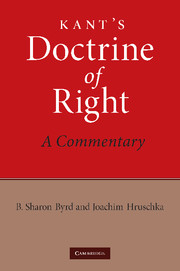Book contents
- Frontmatter
- Contents
- Introduction and methods of interpretation
- Chapter 1 The idea of the juridical state and the postulate of public law
- Chapter 2 The state of nature and the three leges
- Appendix to Chapter 2 Iustitia tutatrix, iustitia commutativa, and iustitia distributiva and their differences
- Chapter 3 The right to freedom
- Chapter 4 The permissive law in the Doctrine of Right
- Chapter 5 The external mine and thine
- Chapter 6 Intelligible possession of land
- Chapter 7 The “state in the idea”
- Chapter 8 The state in reality
- Chapter 9 International and cosmopolitan law
- Chapter 10 The “idea of public law” and its limits
- Chapter 11 Contract law I. Why must I keep my promise?
- Chapter 12 Contract law II. Kant's table of contracts
- Chapter 13 Criminal punishment
- Chapter 14 The human being as a person
- Appendix I to Chapter 14 On the logic of “‘ought’ implies ‘can’”
- Appendix II to Chapter 14 The system of rules of imputation
- Bibliography
- Index
Appendix to Chapter 2 - Iustitia tutatrix, iustitia commutativa, and iustitia distributiva and their differences
Published online by Cambridge University Press: 05 June 2012
- Frontmatter
- Contents
- Introduction and methods of interpretation
- Chapter 1 The idea of the juridical state and the postulate of public law
- Chapter 2 The state of nature and the three leges
- Appendix to Chapter 2 Iustitia tutatrix, iustitia commutativa, and iustitia distributiva and their differences
- Chapter 3 The right to freedom
- Chapter 4 The permissive law in the Doctrine of Right
- Chapter 5 The external mine and thine
- Chapter 6 Intelligible possession of land
- Chapter 7 The “state in the idea”
- Chapter 8 The state in reality
- Chapter 9 International and cosmopolitan law
- Chapter 10 The “idea of public law” and its limits
- Chapter 11 Contract law I. Why must I keep my promise?
- Chapter 12 Contract law II. Kant's table of contracts
- Chapter 13 Criminal punishment
- Chapter 14 The human being as a person
- Appendix I to Chapter 14 On the logic of “‘ought’ implies ‘can’”
- Appendix II to Chapter 14 The system of rules of imputation
- Bibliography
- Index
Summary
In what follows we digress from the last chapter to sketch Kant's train of thought leading to the three institutions (iustitia tutatrix, iustitia commutativa, and iustitia distributiva). This digression should also make Kant's terminology more transparent. We show that Kant originally distinguished only between commutative justice and distributive justice, and did not discuss the idea of protective justice as embodied in the iustitia tutatrix at all. As noted in Chapter 1, Kant does not use the Scholastic understanding of commutative and distributive justice. For the Scholastics, commutative and distributive justice were virtues. For Kant, in contrast, they are institutions. We explain the radical change between the Scholastic and Kant's views of these two types of justice, tracing this change to Hobbes. Indeed, Hobbes not only provides the frame of reference for Kant's definitions of commutative and distributive justice, but also formulates an early version of what for Kant later becomes the postulate of public law with its dictate to move to a juridical state. Kant refines Hobbes' concepts and ultimately adopts a third – protective justice – by the time he writes the Doctrine of Right.
KANT'S DEVELOPMENT OF HOBBES' DISTINCTION BETWEEN COMMUTATIVE AND DISTRIBUTIVE JUSTICE
We find the background for Kant's ideas on public justice in Hobbes' thoughts on the concepts iustitia commutativa and iustitia distributiva. In Leviathan, as in De Cive, Hobbes rejects the Aristotelian-Scholastic tradition and with it the Scholastic definitions of commutative and distributive justice.
- Type
- Chapter
- Information
- Kant's Doctrine of RightA Commentary, pp. 71 - 76Publisher: Cambridge University PressPrint publication year: 2010



